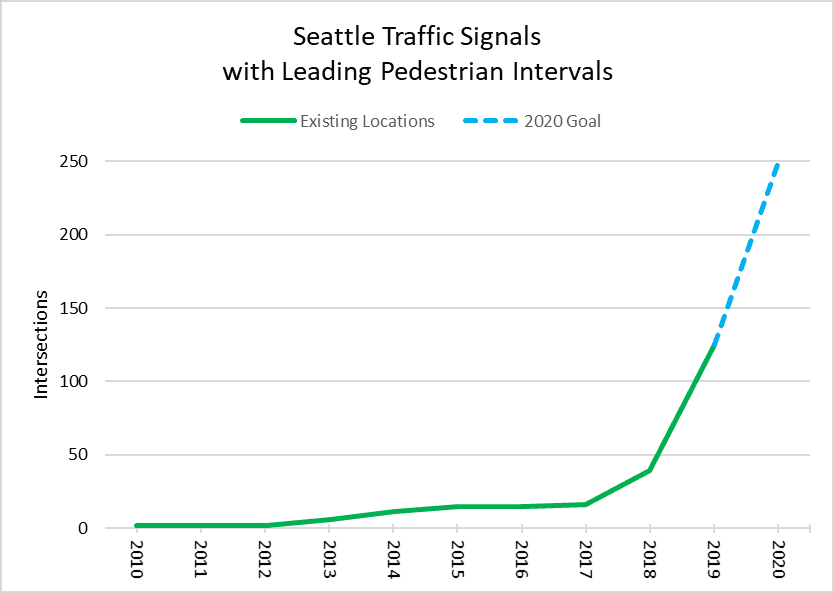

Caption: Preschool children using a brand new traffic signal in Fremont. Photo courtesy of Fremont.com and Fremont Chamber of Commerce.
Of all the things we do to keep Seattle moving, public safety is by far our absolute highest priority.
Mayor Jenny Durkan has announced four steps on December 10 to make our streets even safer and achieve our Vision Zero goal of ending traffic deaths and serious injuries on city streets by 2030. Along with lowering speed limits, one critical step is enhancing safety for people walking and rolling as they cross the street by installing leading pedestrian intervals.
An alarmingly high number of serious crashes take place at crosswalks when people turning in cars hit people crossing the street.
Installing leading pedestrian intervals (the technical term for re-timing traffic signals to give people a few seconds head start to begin walking across the street before people in cars get a green light) is one way to enhance safety. People in the crosswalks become more visible to people driving and this method has proven to reduce crosswalk collisions by 60%.
Preventing crashes with a few seconds head start for a pedestrian.
New York City Department of Transportation: Deaths and serious injuries dropped by 40%.
We’re committing to double the number of leading pedestrian intervals next year to 250 locations. That’s 25% of the traffic signals in Seattle.
We’re excited to announce signal upgrades are going way faster than we announced earlier this year. So we set a more ambitious goal and are committing to double the current number of leading pedestrian intervals by the end of 2020.
We prioritize safety upgrades where we’ve seen a concerning history of collisions, in urban centers, & near buildings like schools, hospitals, & community centers.
We also add leading pedestrian intervals every time we do other traffic signal maintenance work that creates the opportunity unless there’s a specific reason why it does not make sense in a particular location.
Look out for each other.
While we’re excited about increasing the number of LPIs across the city, we also want to take a moment to remind everyone that we all have a role to play in improving safety.
As you’re traveling Seattle’s streets, look out for yourself and for each other. Recognize that every intersection is unique, so stay alert. If you’re driving, pay attention, slow down, and expect people are walking and biking in every part of the city at all times of day.
With your help, and with changes big and small, we can get closer to our Vision Zero goal of ending traffic deaths and serious injuries on city streets by 2030.
Safety is the top priority when we install new traffic signals.
Building new traffic signals is another way we’re working to enhance safety by using city-wide collision data to help prioritize where signals are most needed.
Some of the new traffic signals we’ve built this year include 1st Ave NW & NW 36th St in Fremont, the Smith Cove Cruise Terminal at Pier 91, and 35th Ave NE & NE 68th St in Wedgwood. Next year, we plan to build new traffic signals along high traffic areas in South Seattle, High Point, Bitter Lake, and Lake City.

A traffic signal at Aurora Ave N & N 92nd St lets school children press a button to control when cars get a red light. Collisions in this area have dropped by 50% since this push-button signal was built in 2017. Photo courtesy of Dongho Chang
We’re also planning to keep on working on other ways to make traffic signals safer for people walking, rolling, and biking.
In 2020, we plan to make updates to our traffic signal policy, including the guidelines we use to make sure people of all ages and abilities have enough time to get across the street safely.
We’ll also be taking a look at how we use push-buttons to address frustrations we’ve heard. We don’t want to make you press a button if you don’t need to, and there are also some places where giving pedestrians control to stop car-traffic makes the most sense. So we want to make sure that we’re programming these buttons consistently with a pedestrian’s perspective in mind.
The goal will be to balance the needs of all modes of transportation so that everyone can get where they need to go safely and conveniently.



